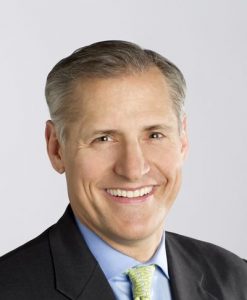Rotary is a global network of 1.2 million neighbors, friends, leaders, and problem-solvers who see a world where people unite and take action to create lasting change – across the globe, in our communities, and in ourselves. John Hewko, General Secretary of Rotary International.
By Peter Lee, Blockchain Industry Group, and John Hewko, General Secretary of Rotary International
Rotary International – https://www.rotary.org/
LinkedIn Profile – John Hewko
Peter Lee: John, please tell us about yourself and your background as well as about Rotary International and its membership composition and priorities?
John Hewko: As general secretary of Rotary International, I lead a team of 800 professionals who support Rotary members in their efforts to bring positive, lasting change to communities worldwide.
Rotary is a membership organization made up of people of action who use their professional and leadership skills to identify solutions and take action to address humanitarian challenges facing us today. We work to create a world where people unite and take action to create lasting change – across the globe, in our communities, and in ourselves.
Our top priority is the global eradication of polio. Along with our partners in the Global Polio Eradication Initiative, we’ve reduced cases of polio by more than 99.9 percent, from about 350,000 cases a year three decades ago to just 22 confirmed in 2017.
Before joining Rotary in 2011, I was vice president of operations and compact development at the Millennium Challenge Corporation. MCC is a U.S. government agency established to deliver foreign assistance that emphasized the responsibility and empowerment of the host nation; in other words-assistance that rewarded high performance, that got results through innovation.
Peter: John, that’s very impressive. Let me also let our members know that Rotary has 1.2 million members in 35,000 clubs worldwide; and that you manage revenues of $506 million and assets of $1.2 billion.
John: Thanks, Peter. Yes, Rotary has members in virtually every corner of the world who support the organization through volunteerism and donations. And of course we always welcome new members who want to take action and connect with others to make a difference in their communities.
I’m honored to be able to manage such a reputable organization and to be a Rotary member myself.
Peter: Who benefits from the Rotary, what does the Rotary do, and why do people join?
John: Rotary benefits just about everyone, from our members to the communities they serve. We’ve helped protect more than 2.5 billion children from polio. Each year, The Rotary Foundation – our charitable arm, provides more than $250 million to end polio and support sustainable projects and scholarships that promote peace, fight disease, provide clean water and sanitation, support education, save mothers and children and grow local economies.
Belonging to a Rotary club allows people from different cultures and nationalities to establish lifelong friendships and professional business networks that transcend political and cultural boundaries and tensions. Before Facebook, Instagram and SnapChat, you had Rotary – an organization that thrived off of connections and people meeting from all over the world.
Peter: In at least a superficial level, I hear a lot about organizations such as the Red Cross, Doctors Without Borders, Habitat for Humanity, Greenpeace etc… but not a lot about Rotary and it’s many philanthropic and important activities. Why is that and does it matter?
John: We know that Rotary clubs are making an impact around the world and we are, above all, committed to service in both the causes we champion and in the effort to end polio. But, of course, we do want more people to have Rotary top of mind when they think of organizations that are making communities and the world better.
For the past several years, we have undertaken a brand strengthening effort aimed at helping Rotary and our clubs tell a clearer, compelling and effective story about who we are and the impact that we make. That work is ongoing but we do believe it has borne fruit. We were recently ranked no.3 in a CNBC and Charity Navigator profile of the top 10 charities changing the world in 2016 and we surpassed our target of $1 billion in current and projected endowment assets two years early.
Interest in joining Rotary has increased annually on average by 21 percent. So we know that community, professional and civic minded leaders continue to see us as a premiere destination to not only network professionally but, also to connect and take action.
Peter: Given that Rotary has been around for more than 110 years, what are the biggest challenges to staying relevant for so long in changing times?
John: Organizations in the twenty-first century must structure themselves in ways that encourage sustained engagement opportunities, especially with respect to a millennial generation that tends to identify with causes and social impact more than with hierarchically organized institutions.
Staying relevant in a rapidly changing world also involves setting audacious, transformational organizational goals that serve to engage and motivate members and supporters. In Rotary’s case, the big one has been the eradication of polio globally.
As the world rises to the challenge of a new set of ambitious United Nations Sustainable Development Goals, nonprofits able to blend commerce and cause will play a key role. Organizations that do this effectively also will be well positioned to meet millennials’ insistence on integrity, accountability, and social good as core corporate values.
At Rotary, the promotion of business ethics and our focus on maximizing positive social good is a core organizational principle. If we stay true to our DNA while taking steps to stay relevant; make big and audacious goals that motivate our teams and mobilize our supporters; and maximize our impact through smart partnerships – we’ll remain relevant and thrive in the years to come.
Peter: What type of people become Rotary members? Can you provide some examples of Rotary members and what they’ve accomplished?
John: Rotary members are people of action who not only identify problems, but find solutions for those problems and take action to address them. Take for instance, Peggy Halderman, an advocate for hungry schoolchildren. In 2008, she learned that more than 900 children participated in the Free/Reduced Lunch program in Golden, Colorado; and well over half of them did not have adequate food on weekends. After bringing this to the attention of her Rotary club, city manager, mayor, and city council, Peggy started the Golden Backpack Program, which provides weekend food to kids in need and aims to eliminate childhood hunger in Golden.
Evelyn Abad, a retired nurse and member of the Rotary Club of San Francisco donates her time with Rotaplast International, a humanitarian organization providing free reconstructive operations and treatment for children in need worldwide. Rotaplast has operated on over 17,000 patients, 186 missions and worked in 24 countries for the last 25 years.
Safina Rahman, a member of the Rotary Club of Dhaka Mahanagar, is an advocate for women’s rights in the workplace in Bangladesh. As a garment factory owner, she was the first to offer health insurance and maternity leave for her female employees.
There are many more members who have a story to tell, and for me, these remarkable acts of service are what define Rotary.
Peter: How do you go about recruiting Rotary members? What forms of marketing and promotion do you use to do that? How much social media do you use and is it mostly word of mouth?
John: The top reasons people join Rotary are to meet new people, network professionally and get involved in their communities.
We encourage clubs to invite people in their communities to help with a service project, attend a networking night, or participate in a club gathering so they can see for themselves how Rotary connects leaders to make positive change.
Raising public awareness and understanding of Rotary is also key to growing our clubs. Our People of Action global advertising campaign gives clubs the tools and templates they need to effectively localize ads that they can use to promote Rotary in their communities.
We have strengthened our social media presence. In addition to our official channels, most of our clubs have a social media footprint as well.
And through the lives Rotary has touched, whether a humanitarian project, a cultural exchange, or a scholarship, there is a strong motivation for them to join and pay it forward. I couldn’t put it better than Heather Klein, one our members from North Carolina, who said: “I joined to make a difference in my community. I’ve stayed because I am.”
Peter: What has surprised you most about your Rotary members?
John: I am often surprised and very impressed by the tenacity of our members. They are the beating heart of Rotary. More than 30 years ago, Rotary members had the audacity to set a goal to eradicate polio – a disease that was severely impacting the quality of life of children everywhere. We’re still fighting and the dedication of Rotary members continues to hold me in awe. Most people would have given up on the fight by now or become discouraged. But today, Rotary members are working even harder to rid the world of this terrible disease. And while there is still work to be done, we’re almost there.
Peter: Rotary has helped wipe out 99.9 percent of all polio cases. Why the continued emphasis on polio and not other diseases such as malaria, tuberculosis or HIV/AIDS that are killing more people on a yearly basis?
John: Rotary’s main focus is the eradication of polio and we will not relinquish our fight until we can proudly say the world is polio free. Until polio is 100% wiped out, we still have work to do.
When Rotary started the global initiative to end polio 30 years ago, there were 350,000 cases of polio every year – nearly 1,000 per day. The reason that polio today impacts such a small number of children – just 22 in 2017 – is thanks to the persistence of our members and partners. We continue to immunize 450 million children each year to ensure that number stays low, and to ultimately bring it to zero.
Keeping polio-free countries polio-free is a massive undertaking. It means reaching children in conflict-impacted places where health workers can’t safely travel; reaching children who live in villages that are inaccessible due to everything from flooding to poor infrastructure; and, reaching children in nomadic families who don’t live in one place long enough to get consistent healthcare.
If we stop vaccinating, polio will grow to 200,000 annual cases within ten years. For Rotary, that is not acceptable.
For us, the only solution is reaching zero cases through eradication. We committed thirty years ago to a world in which no child would have to suffer polio’s paralyzing impact, and we remain steadfast in our commitment to that goal today.
While eliminating polio is our main focus, Rotary has six areas of focus: promoting peace, fighting disease, providing clean water and sanitation, supporting education, saving mothers and children and growing local economies. The Rotary Foundation grants more than $250 million to clubs around the world for projects in these areas.
Through our six areas of focus, we are actually tackling most of the things you mentioned. Take for example Stephen Baker, a retired salesman who developed the Mosquitero Project – an insecticide-treated bed net that fits over the hammocks used in Venezuela. He’s a member of the Rotary Club of Key Biscayne in Florida. Not only do these nets create a physical barrier between the sleeper and infected mosquitoes, they can actually kill mosquitoes that come in direct contact with the treated netting material while being harmless to humans. The Mosquitero Project is being credited for an 80% reduction in malaria where they are used.
Marion Bunch – a mom who lost her son, Jerry, to AIDS in 1994 and member of the Rotary Club of Atlanta, founded Rotarians for Family Health and AIDS Prevention an organization working to protect families from HIV/AIDS and other preventable diseases like TB, Malaria, Diabetes, Hypertension and more through their signature program, Rotary Family Health Days (RFHD). RFHD provides free health services to underprivileged people in Africa and India. The program has served over 1.2 million people.
Peter: What is Rotary’s primary focus and what does it hope to accomplish in the future?
John: My first priority is to see that we achieve our top goal of eradicating polio worldwide.
I also want to see Rotary viewed as a critical player that contributes thoughts and ideas on how to effectively promote sustainable economic development in the world.
For the future, I see a Rotary that is:
- active in every community;
- one that connects with and builds relationships with the entire community;
- one that mentors those looking to improve their skills — leadership, vocational, personal, social, educational, or others;
- one that partners with governments and NGOs in their community and around the world to end poverty, to wipe out preventable disease, and to stop conflicts before they start.
I see a Rotary where we are top of mind and tip of tongue for anyone in the community who wants to join an organization to give back, but also to network professionally and to gain lifelong friends, skills, and expertise.
While attending the World Economic Forum in Davos in January, I spoke with many global leaders in all sectors who wanted to see a future application of the fantastic global health infrastructure and knowhow that has been built by Rotary and our partners with the Global Polio Eradication Initiative.
This vital capacity for Rotary to play a leading role in global health initiatives and other sustainable development priorities will be top of mind as we consider our next steps after polio is gone.
Peter: Do you see any potential new medical, technological or other type of game changers out there that might be able to eradicate a disease or solve a problem that’s been vexing the world and Rotary?
John: In the case of polio, we already have the necessary tools at our disposal. It’s the question of mobilization and will, and Rotary has answered this question for three decades through the power of our volunteer network.
In the future, our success will be defined by our ability to fuse the best of new technology with our unique human network.
Ultimately, there is no replacement for the power of our member’s compassion because science alone would not have brought us to the cusp of eliminating polio.
Technology and human commitment must work hand in glove. We use smartphones to bring people to health camps, but no smartphone can convince a fearful parent that they should accept the polio vaccine for their child.
No computer can build trust like a Rotary member who makes a commitment and keeps their word. Because innovation without a cause will not serve those in need. And a clear cause without innovation will also fall short.
Peter: What other person or organization do you see doing a great job in the philanthropic and charitable field?
John: The Bill & Melinda Gates Foundation is doing a great job at fighting inequality and empowering people in every corner of the globe through education and economic opportunity amongst other things. The Bill & Melinda Gates Foundation is also our partner in the fight against polio. In fact, they triple any polio donation made to Rotary.
Peter: How have you challenged yourself in your personal life and which is something our audience might not know?
John: I am an avid cyclist. This past November, I challenged myself by participating in a 106-mile bike ride in Arizona after having hip replacement surgery last April. Though this was my fifth time joining the ride, it was the first time I’d ever attempted this trek after surgery. My wife, several Rotary members and Rotary International staff joined me on this ride and we raised over $11 million for polio eradication. It was a daunting task, especially with my artificial hip, but I finished the ride and I’ve never felt better!

John Hewko
General Secretary
Rotary International



